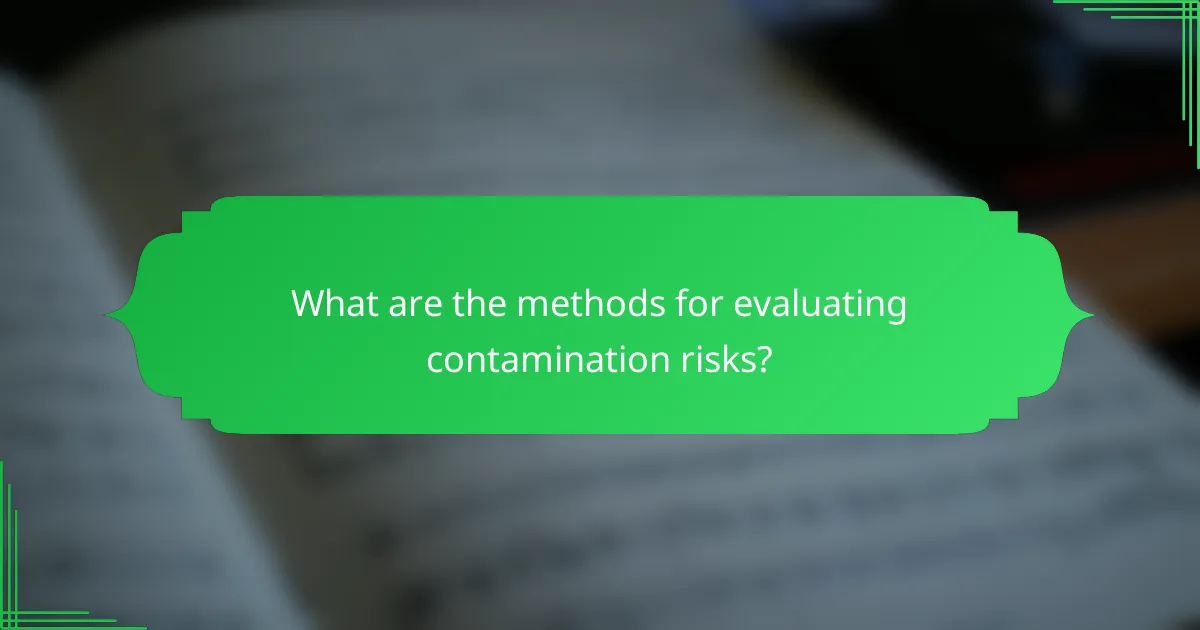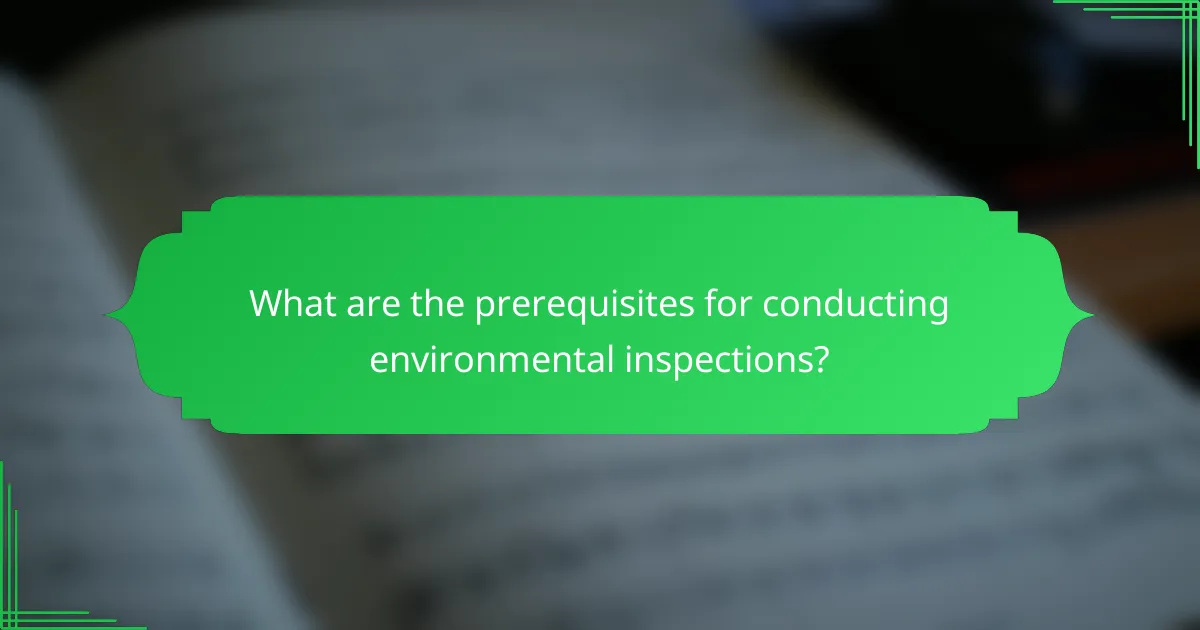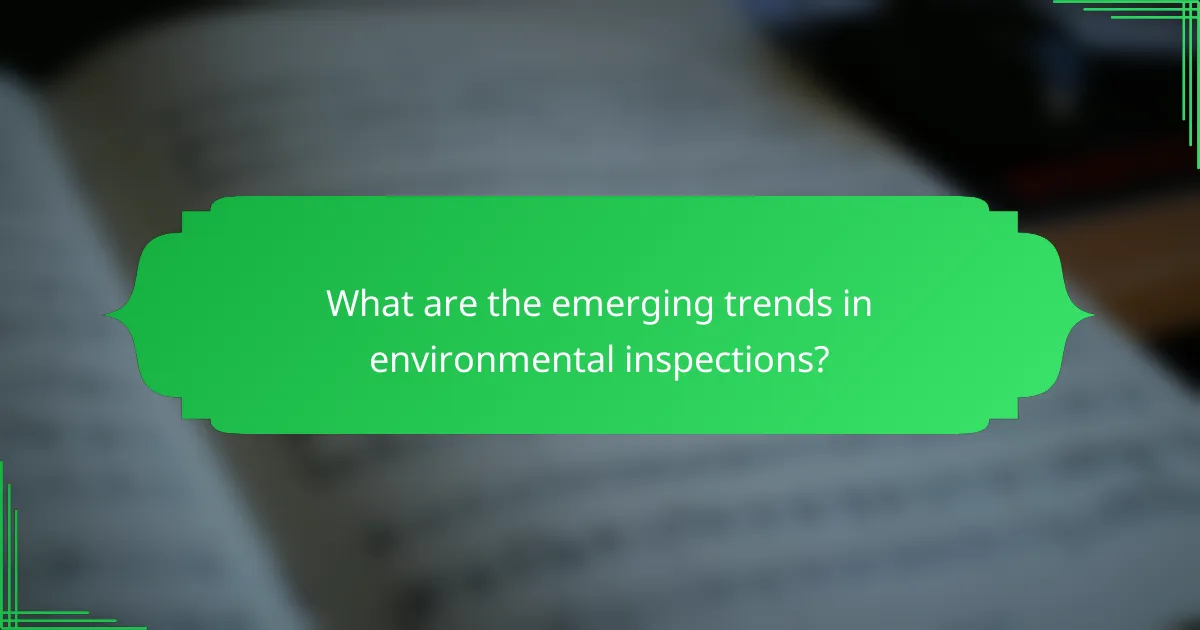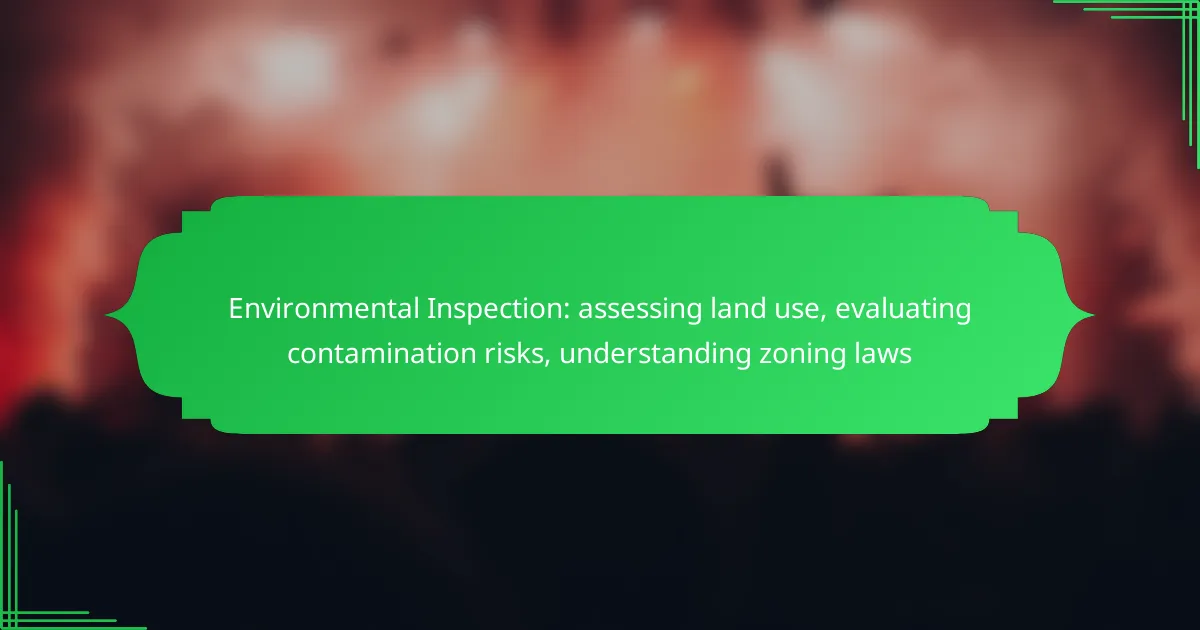Environmental inspections play a vital role in assessing land use, evaluating contamination risks, and understanding zoning laws. By examining how land is utilized and identifying potential hazards, these inspections ensure compliance with regulations that protect public health and the environment. Key methods such as soil sampling and groundwater testing provide essential data for informed decision-making regarding land development and usage.

How to assess land use in environmental inspections?
Assessing land use in environmental inspections involves evaluating how land is utilized and identifying potential contamination risks. This process is crucial for ensuring compliance with zoning laws and environmental regulations.
Land use mapping techniques
Land use mapping techniques are essential for visualizing how land is allocated for various purposes, such as residential, commercial, or industrial use. Common methods include aerial photography, satellite imagery, and on-the-ground surveys. Each technique has its strengths; for instance, aerial photography provides a broad overview, while ground surveys offer detailed insights.
When mapping land use, consider the scale and resolution needed for your analysis. High-resolution images may be necessary for urban areas, while broader views suffice for rural regions. Always ensure that the mapping techniques align with the specific goals of your environmental inspection.
GIS technology applications
Geographic Information Systems (GIS) technology plays a vital role in assessing land use by allowing for the integration and analysis of spatial data. GIS can help visualize patterns, analyze relationships, and predict future land use changes. For example, GIS can overlay zoning maps with contamination data to identify at-risk areas.
Utilizing GIS effectively requires familiarity with software tools and an understanding of spatial analysis principles. Training in GIS can enhance the accuracy of your assessments, making it easier to communicate findings to stakeholders and regulatory bodies.
Data sources for land use analysis
Data sources for land use analysis include government databases, environmental studies, and local planning documents. National and regional agencies often provide valuable datasets, such as land use inventories and zoning regulations. These resources can help establish a baseline for your assessments.
In addition to public data, consider leveraging community input and local knowledge, which can provide context that raw data may lack. Engaging with local stakeholders can also reveal historical land use patterns and potential contamination sources that may not be documented elsewhere.

What are the methods for evaluating contamination risks?
Evaluating contamination risks involves several methods that assess the presence of hazardous substances in the environment. Key methods include soil sampling, groundwater testing, and risk assessment frameworks, each providing critical data for understanding potential environmental impacts.
Soil sampling procedures
Soil sampling is a fundamental method for assessing contamination risks. It typically involves collecting soil samples from various depths and locations to identify contaminants such as heavy metals, pesticides, or hydrocarbons. Samples should be taken from areas suspected of contamination and at different depths to provide a comprehensive overview.
When conducting soil sampling, it’s essential to follow standardized procedures to ensure the reliability of results. This includes using clean tools, labeling samples accurately, and storing them properly until analysis. Common practices suggest collecting at least three samples from each site to account for variability.
Groundwater testing protocols
Groundwater testing is crucial for evaluating contamination risks, especially near industrial sites or landfills. This process involves collecting water samples from wells or boreholes to test for pollutants like nitrates, volatile organic compounds, and heavy metals. Regular monitoring is recommended to track changes over time.
Protocols for groundwater testing should adhere to established guidelines, such as those from the Environmental Protection Agency (EPA) in the United States. Sampling frequency and locations should be determined based on potential sources of contamination, with a focus on areas where groundwater is used for drinking or irrigation.
Risk assessment frameworks
Risk assessment frameworks provide a structured approach to evaluate the potential health and environmental impacts of contaminants. These frameworks typically include hazard identification, exposure assessment, and risk characterization. They help in determining the likelihood of adverse effects based on the level of exposure to contaminants.
When applying a risk assessment framework, it’s vital to consider local regulations and community standards. For instance, the acceptable levels of certain contaminants may vary by region, influenced by local health guidelines or environmental policies. Engaging stakeholders during the assessment process can also enhance the effectiveness and acceptance of the findings.

How do zoning laws impact environmental inspections?
Zoning laws significantly influence environmental inspections by dictating how land can be used and what activities are permissible in specific areas. These regulations help assess potential contamination risks and ensure compliance with environmental standards, ultimately guiding land use decisions and development projects.
Understanding local zoning regulations
Local zoning regulations define the permissible uses of land within a municipality, categorizing areas into residential, commercial, industrial, and agricultural zones. Each category has specific rules regarding building heights, density, and types of activities allowed. Familiarity with these regulations is essential for environmental inspections, as they determine the scope of potential contamination and land use conflicts.
Inspectors must review zoning maps and local ordinances to understand restrictions and requirements that may affect land development or remediation efforts. This knowledge aids in identifying areas that may require more rigorous environmental assessments.
Impact of zoning on land use
Zoning laws directly affect land use by controlling the types of activities that can occur in different areas. For example, industrial zones may allow manufacturing and storage, which could increase contamination risks, while residential zones typically have stricter regulations to protect public health. Understanding these distinctions helps inspectors evaluate potential environmental hazards effectively.
Moreover, zoning can influence property values and development opportunities. Properties in areas with favorable zoning may attract more investment, while those in restrictive zones may face challenges, impacting their environmental assessments and remediation strategies.
Case studies of zoning law applications
Case studies illustrate the practical implications of zoning laws on environmental inspections. For instance, a city that rezoned an industrial area to residential prompted extensive environmental assessments due to historical contamination from manufacturing activities. This change required thorough inspections to ensure safety for future residents.
Another example involves a municipality that implemented stricter zoning regulations around wetlands to protect these ecosystems. Environmental inspections in these areas focused on assessing the impact of nearby developments and ensuring compliance with conservation efforts, highlighting the interplay between zoning laws and environmental protection.

What are the prerequisites for conducting environmental inspections?
Conducting environmental inspections requires specific knowledge, skills, and resources to effectively assess land use, evaluate contamination risks, and understand zoning laws. Inspectors must be equipped with the necessary certifications, tools, and equipment to ensure compliance with local regulations and standards.
Necessary certifications for inspectors
Environmental inspectors typically need certifications that demonstrate their expertise in environmental science and regulations. Common certifications include the Certified Environmental Inspector (CEI) and the Hazardous Materials Manager (CHMM). These credentials often require passing exams and completing continuing education to stay current with evolving laws and practices.
In some regions, specific state or local certifications may also be required, particularly for inspections involving hazardous materials or specific types of land use. Inspectors should verify the certification requirements relevant to their area to ensure compliance.
Required tools and equipment
Inspectors need a variety of tools and equipment to conduct thorough environmental assessments. Essential items include soil sampling kits, groundwater testing equipment, and air quality monitoring devices. These tools help evaluate contamination risks effectively.
Additionally, inspectors may use Geographic Information Systems (GIS) software to analyze land use and zoning data. Having access to a reliable vehicle for site visits and appropriate personal protective equipment (PPE) is also crucial for safety during inspections.

How to choose an environmental inspection service?
Choosing an environmental inspection service involves evaluating their qualifications, experience, and the specific services they offer. Prioritize companies that demonstrate expertise in assessing land use, contamination risks, and zoning laws relevant to your area.
Criteria for selecting qualified inspectors
When selecting qualified inspectors, consider their certifications, such as those from recognized environmental organizations. Look for inspectors with experience in your specific type of property or land use, as familiarity with local regulations can significantly impact the inspection’s effectiveness.
Additionally, assess their reputation through client reviews and case studies. A strong track record of successful inspections and satisfied clients can indicate reliability and professionalism.
Comparative analysis of inspection companies
To conduct a comparative analysis of inspection companies, create a checklist of essential factors such as pricing, services offered, and turnaround time for reports. This can help you identify which companies meet your needs best.
Consider reaching out to multiple companies for quotes and service descriptions. Comparing these aspects will allow you to make an informed decision based on both quality and cost, ensuring you choose a service that fits your budget while meeting your environmental inspection requirements.

What are the emerging trends in environmental inspections?
Emerging trends in environmental inspections focus on integrating advanced technologies, adapting to new regulations, and addressing future challenges in environmental assessments. These trends aim to enhance the accuracy and efficiency of inspections while ensuring compliance with evolving standards.
Technological advancements in inspections
Technological advancements are revolutionizing environmental inspections by utilizing tools like drones, remote sensing, and artificial intelligence. These innovations allow for more comprehensive data collection and analysis, improving the identification of contamination risks and land use issues.
For example, drones can cover large areas quickly, capturing high-resolution images that help assess land conditions. Additionally, AI can analyze data patterns to predict potential environmental hazards, making inspections more proactive rather than reactive.
Regulatory changes affecting inspections
Regulatory changes are significantly impacting environmental inspections, with many countries tightening standards for contamination and land use assessments. New regulations often require more rigorous testing and reporting, which can increase the complexity and cost of inspections.
Inspectors must stay updated on local laws, such as the Clean Water Act in the U.S. or the Environmental Protection Act in the UK, to ensure compliance. Understanding these regulations is crucial for avoiding penalties and ensuring that inspections meet legal requirements.
Future challenges in environmental assessments
Future challenges in environmental assessments include adapting to climate change impacts, managing urbanization, and addressing public concerns about environmental health. As cities expand, the pressure on land use increases, complicating inspections and evaluations.
Furthermore, climate change may introduce new contamination risks, requiring inspectors to develop strategies for assessing and mitigating these threats. Keeping abreast of scientific research and community needs will be essential for effective environmental assessments moving forward.
